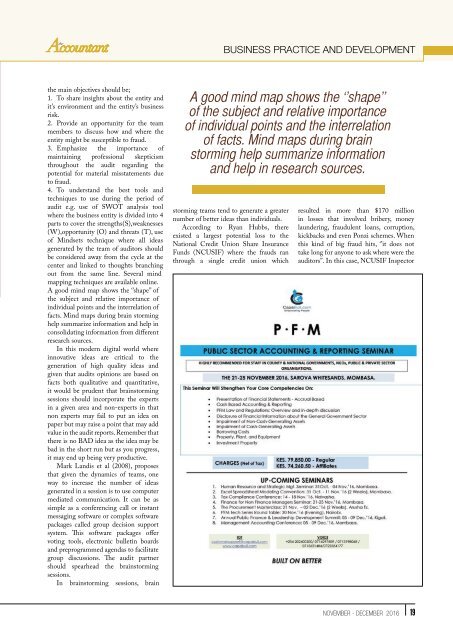The Accountant Nov-Dec 2016
Create successful ePaper yourself
Turn your PDF publications into a flip-book with our unique Google optimized e-Paper software.
Business Practice and Development<br />
the main objectives should be;<br />
1. To share insights about the entity and<br />
it’s environment and the entity’s business<br />
risk.<br />
2. Provide an opportunity for the team<br />
members to discuss how and where the<br />
entity might be susceptible to fraud.<br />
3. Emphasize the importance of<br />
maintaining professional skepticism<br />
throughout the audit regarding the<br />
potential for material misstatements due<br />
to fraud.<br />
4. To understand the best tools and<br />
techniques to use during the period of<br />
audit e.g. use of SWOT analysis tool<br />
where the business entity is divided into 4<br />
parts to cover the strengths(S),weaknesses<br />
(W),opportunity (O) and threats (T), use<br />
of Mindsets technique where all ideas<br />
generated by the team of auditors should<br />
be considered away from the cycle at the<br />
center and linked to thoughts branching<br />
out from the same line. Several mind<br />
mapping techniques are available online.<br />
A good mind map shows the ‘’shape’’ of<br />
the subject and relative importance of<br />
individual points and the interrelation of<br />
facts. Mind maps during brain storming<br />
help summarize information and help in<br />
consolidating information from different<br />
research sources.<br />
In this modern digital world where<br />
innovative ideas are critical to the<br />
generation of high quality ideas and<br />
given that audits opinions are based on<br />
facts both qualitative and quantitative,<br />
it would be prudent that brainstorming<br />
sessions should incorporate the experts<br />
in a given area and non-experts in that<br />
non experts may fail to put an idea on<br />
paper but may raise a point that may add<br />
value in the audit reports. Remember that<br />
there is no BAD idea as the idea may be<br />
bad in the short run but as you progress,<br />
it may end up being very productive.<br />
Mark Landis et al (2008), proposes<br />
that given the dynamics of teams, one<br />
way to increase the number of ideas<br />
generated in a session is to use computer<br />
mediated communication. It can be as<br />
simple as a conferencing call or instant<br />
messaging software or complex software<br />
packages called group decision support<br />
system. This software packages offer<br />
voting tools, electronic bulletin boards<br />
and preprogrammed agendas to facilitate<br />
group discussions. <strong>The</strong> audit partner<br />
should spearhead the brainstorming<br />
sessions.<br />
In brainstorming sessions, brain<br />
A good mind map shows the ‘’shape’’<br />
of the subject and relative importance<br />
of individual points and the interrelation<br />
of facts. Mind maps during brain<br />
storming help summarize information<br />
and help in research sources.<br />
storming teams tend to generate a greater<br />
number of better ideas than individuals.<br />
According to Ryan Hubbs, there<br />
existed a largest potential loss to the<br />
National Credit Union Share Insurance<br />
Funds (NCUSIF) where the frauds ran<br />
through a single credit union which<br />
resulted in more than $170 million<br />
in losses that involved bribery, money<br />
laundering, fraudulent loans, corruption,<br />
kickbacks and even Ponzi schemes. When<br />
this kind of big fraud hits, ‘’it does not<br />
take long for anyone to ask where were the<br />
auditors’’. In this case, NCUSIF Inspector<br />
NOVEMBER - DECEMBER <strong>2016</strong> 19

















